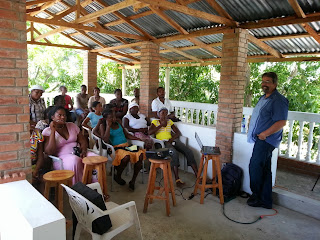Small Business Development: Haiti
 |
| Jim Crandall training new entrepreneurs. |
In addition to a healthy, efficient production system, a business needs a business plan to guide decisions about facilities, production, and marketing, with an eye towards profitability and long-term sustainability. This past June, F2F volunteer Jim Crandall applied his experience in cooperative business development to assist producer networks in Haiti. His focus was on enabling producers to make business decisions based on the network as a whole, not just on individuals.
Jim spent his first week in the Port-au-Prince area working specifically with two rabbit producer associations. He led sessions with the leadership committees of each association, and together they edited and refined cash flow spreadsheets and developed proposed budgets for their networks. This process allowed the committees to better prepare for expenses including maintenance of the processing facility, payment of quality assurance inspectors, or farmer education.
Jim also coached committee members on how to raise start-up funds to get their associations underway and how to attract more members to their associations. Associations can benefit farmers by grouping products from several farms for joint marketing. This larger quantity, enhanced by consistent quality, allows farmers to access markets they might otherwise be unable to access as individuals. Another component of associations is member education, which enhances the work of individual members and in turn improves product quality.
 |
| Steering committee for the Sibert Rabbit Marketing Association. |
Jim reflected that “The business development process is a long process. It builds upon itself, and is truly never completed. A business plan is always being revised and updated to reflect new conditions and information. It is a living breathing document that includes a written plan as a “roadmap” and a financial plan for resource acquisition and expenditure.”

.png)

Comments
Post a Comment